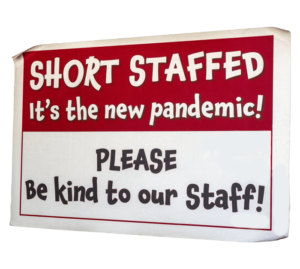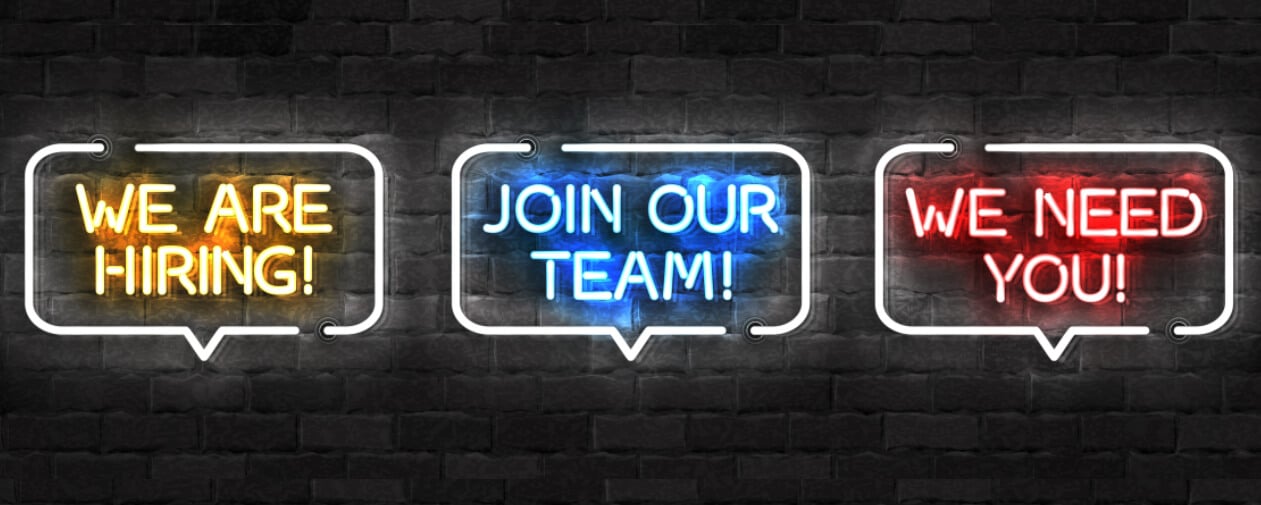The War for Talent: Is Winning Possible?
Everyone is feeling the pinch of the labor shortage in one way or another. You might stop at your local fast-food restaurant and find it and even the drive-through closed. At other times, the drive-thru will be open, but not always according to the posted hours.
Or, you stop at the nearby grocery store to pick up all the things on your list and you find that a third of the items are out of stock, yet it’s different stuff than when you last shopped. As a store employee rushes by, you stop to ask, “I’m finding a lot of stuff out of stock, what’s going on?” They answer that they have supply chain issues due to people shortages.
On a different day, perhaps you’re shopping for a couch, a car, a new gaming system, a new computer… and you hear the same mantra. Catching a flight at the airport? It may be delayed or canceled. Again if you ask why, they say it’s a labor shortage. I don’t remember a time in my half-century of life when I have faced so much trouble buying a car, a house, or a burger! Why is it so crazy? I ask all the time and I hear, “There’s just not enough people to do the work.” And I wonder how that is possible.
Sure, we have the pandemic, but we had enough workers before COVID-19 and now we suddenly don’t, which is baffling. Obviously, it’s not that there physically aren’t enough people. In fact, according to a September 4, 2021, Washington Post article, “There are 10 million job openings, yet more than 8.4 million unemployed are still actively looking for work.” What gives?
Reasons For the Labor Shortage Are Complex
 Many surmise that a big reason for the shortage directly relates to the U.S. government having paid people to stay home. Some say that people simply aren’t motivated to come back to work after getting paid to stay home for up to 86 weeks. (Yes, so far, some people were paid to stay home for up to 86 weeks.) Could this all come to an end as benefits are set to expire (although some states may extend benefits based on President Biden’s urging)? With so many states ending stimulus unemployment benefits, will that mean an end to the crisis? Maybe not.
Many surmise that a big reason for the shortage directly relates to the U.S. government having paid people to stay home. Some say that people simply aren’t motivated to come back to work after getting paid to stay home for up to 86 weeks. (Yes, so far, some people were paid to stay home for up to 86 weeks.) Could this all come to an end as benefits are set to expire (although some states may extend benefits based on President Biden’s urging)? With so many states ending stimulus unemployment benefits, will that mean an end to the crisis? Maybe not.
There are several key factors that contributed to the current labor shortage. Like so many other trends – good and bad – that were accelerated by the pandemic, the labor shortage reflects a combination of things that were brewing and becoming volatile, when the pandemic lit the match. The war on talent really started before the pandemic.
Some say it may have started with changes in employee base wages. For years before 2020, cities and states succumbed to pressures to raise their minimum wages. Tinkering with the minimum wage is a tricky and politicized issue, and it is frequently misaligned with other economic factors such as inflation, the consumer price index, and the general cost of living. One wonders why the natural competition for workers hasn’t provoked more pressure to raise the federal minimum wage.
However, these issues aside, we do know that the pay increase demanded by the marketplace was awkward and delayed. As minimum wages slowly rose in many places, some of America’s largest retailers began to adjust up the minimum wage they’d pay in their stores nationally. Other industries and larger companies like Amazon were doing the same. Basically, any big business that had hourly workers was already pushing to $15 hour, which was more than double the federal minimum wage of $7.25. With some of the biggest U.S. employers offering higher pay, what happens to everyone else? Stress on the labor market. Next, enter the powerful punch of the dreaded pandemic.
Then came all the adjustments designed to help U.S. workers and to stimulate the economy. These adjustments were made with the best of intentions (at least I like to believe that), but they ultimately led to many unintended consequences that are disrupting our daily lives in so many ways.
Inversely, economic stimulus has increased consumer spending, but much of that stimulus will likely come to an end this year. “Consumer spending is currently far above pre-pandemic levels thanks to unprecedented monetary and fiscal policies that have backstopped demand by putting money into wallets,” said NRF Chief Economist Jack Kleinhenz in the NRF Monthly Economic Review. “But as the economy moves forward into the later months of 2021, federal aid will be tapering off and there will be an important focus on the ability of the labor market to generate ongoing strength in wages and salaries to support spending. U.S. consumers remain in the mood to spend but the labor market and job creation will play an increasing role in their ability to do so.”
The labor market is a complex ecosystem and all the analysts don’t agree on everything, but what they do agree on is that right now, talent is hard to attract. For many of the reasons I’ve already mentioned, competition is tight. So how do you stand out? Who’s winning this war and how are they doing it?
What Retail Employees Want From Their Employers
According to Indeed.com, it’s all about benefits. Here are the top 15 benefits employees are looking for:

Most of these benefits are focused on full-time employees, many of whom would be classified as white-collar office workers. How do you figure out what makes sense for part-time retail workers? What benefits matter to them? And how do you connect what workers want with what makes sense in a retail and/or part-time scenario?
An article on LaborIQ® by ThinkWhy® mentions respect, benefits, protection, control, adequate staffing, and predictable schedules as the top six things employees want from retailers. Retailers have responded to these desires to attract and keep employees, in various ways.
For example, Target and Walmart both announced in early August 2021 that they’d offer tuition reimbursement for all their employees to bolster their ability to find workers.
As evidenced by the expansion of the gig economy, it is even more clear what workers want.
Many retailers have turned to offering gig-like benefits such as early wage access in response to retail workers’ desire to have more control over their lives, their work/life balance, and their pay. DailyPay, for instance, is a software solution that, at little to no cost to businesses, offers both visibility and access to pay immediately after employees start a job and as they work, so they can get money when they need it. Employees may be able to access their pay without a fee, if they wait a day or two to get it, but there is a fee (similar to an ATM fee) if they want their money instantly. Having early wage access helps them to avoid penalties associated with high-interest pay-day loans, for instance.
MarketSource added this employee benefit this year and we were blown away by the popularity. Those who use it, use it a lot, but not just to get their money out. They are constantly checking their balances…but why?
In an article for Fast Company, the author says, “Research shows that allowing employees to see the wages they’ve earned in real time increases both employee engagement and retention, because it gives them a feeling of certainty and control over their finances. Employers can provide these modern financial solutions without changing payroll or time and attendance.”
Predictable Schedules: An Appreciated Perk
At MarketSource, we knew that giving access to an employee’s pay sooner, faster, and more easily would be advantageous, but we also found that mere real-time visibility was very popular. We soon discovered that gig workers appreciate being able to track their work and the accompanying remuneration shift-to-shift, day-to-day.
The Fast Company article emphasizes the importance of pay-on-demand as an excellent way to ease the stress of income volatility for hourly employees, versus losing them to the gig economy where early wage access is table stakes. “The value in consistent schedules with guaranteed minimum and maximum hours cannot be overstated. This may seem like a tall order, but modern workforce management software simplifies the task of figuring out how many people to hire and keep on staff to efficiently meet requirements.”
The HR mobile app Branch surveyed thousands of hourly workers, revealing schedule stability as the second most important job factor after higher wages.
There are not many built-in benefits for hourly, 1099 gig-based jobs, but in addition to pay-on-demand, retailers should seriously consider offering predictable (but flexible) schedules.
Visibility is critical here, too. Giving employees the ability to coordinate dependable schedules with their manager and view it within a mobile app is a feature MarketSource developed a few years ago as we updated, upgraded, and modernized all of our workforce management, communications, routing, data collection, and learning management tools. All these tools are integrated within an app-based, SSO solution for all of our retail field employees. The new app enables seamless connectivity, efficient communication to and from employees, and instant visibility into their schedules.
We’ve found that creating predictable schedules for our people was key, but then beyond that, part-time employees particularly appreciate the opportunity to capture more hours when and how they want. The upshot is that retailers can offer the ideal combination of flex/gig-economy benefits with the stability and predictability of a standard employee model. In turn, retail managers appreciate the ease of coordinating and tracking schedules to meet staffing requirements while also enhancing employee engagement within a single platform
Six Benefits to Bring Employees Back to Your Store
The Fast Company article notes that the current benefit system no longer serves. “We need a new system of benefits that supports our modern workforce, which includes gig workers, deskless workers, remote staff, and everything in between. As employers seek to rehire, they need to search for ways that they can support and provide value to their staff, or risk losing employees to those who are.”
Here are some key employee benefits that will put retailers in a better position to win the War for Talent:
1. Improved, modernized, app-based employee workplace productivity systems
2. Streamlined, simplified communication available on employees’ preferred devices
3. Experiential training using video and gamification
4. Visibility and access to wages in real time
5. Alignment of opportunities with employees’ personal priorities
6. Predictability of work and schedules
It might be a lot to consider. Fortunately, partnering with MarketSource can help you take the strategic leap you need to quickly and efficiently get all the pieces of the puzzle in place for you. Maximizing people performance is our sole focus. And that’s what retailers need more of right now. LET’S TALK >>

